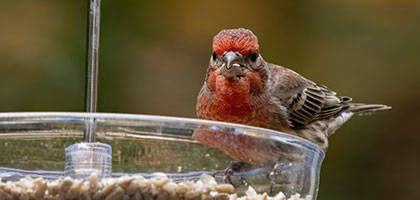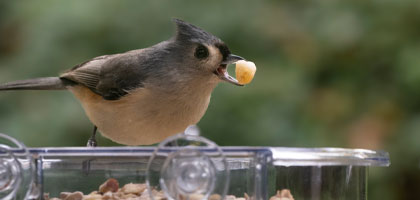Cardinals are a delight to behold. Their vibrant plumage and melodious songs make them a favorite among bird enthusiasts.
But attracting these beautiful birds to your backyard involves more than just setting up a bird feeder. It requires understanding their dietary needs and preferences.
Enter peanuts, a cardinal favorite. These protein-rich nuts are a match made in bird-feeding heaven for cardinals.
In this guide, we'll delve into the world of cardinals and peanuts. We'll explore why these birds love peanuts and how to feed them safely.
We'll also discuss the best cardinal feeders for peanut feeding and how to create a cardinal-friendly environment.
So, whether you're a seasoned bird watcher or a beginner looking to attract cardinals to your yard, this guide is for you. Let's embark on this exciting journey into the world of cardinals and peanuts.
Understanding Cardinal Feeding Habits
Cardinals have diverse diets, enjoying seeds, fruits, and insects. Among their favorites are peanuts, which they relish for their rich taste and nutritional value.
Peanuts provide essential fats and protein that help cardinals thrive. This makes them an excellent source of energy, especially during colder months when natural food is scarce.
Why do cardinals love peanuts? Let's look at some key reasons:
- High-energy content supports their active lifestyle.
- Protein-rich peanuts aid in muscle and feather development.
- Good fats offer warmth in harsh weather conditions.
Their strong beaks make cracking peanuts easy, making them a perfect bird food choice.
Choosing the Right Peanuts for Cardinals
When selecting peanuts for cardinals, opt for unsalted and shelled varieties. These choices ensure the birds' safety and health by avoiding harmful additives and reducing choking hazards.
Salted and flavored peanuts can be harmful, posing significant health risks for cardinals. Excess salt is detrimental to their well-being, and flavors can introduce unsafe additives to their diet.
Consider the following when choosing peanuts:
- Unsalted ensures no excessive sodium intake.
- Shelled prevents choking risks.
- Natural options keep their diet free from additives.
By choosing the right type of peanut, you provide cardinals with a safe, nutritious source of food.
Best Cardinal Feeders for Peanut Feeding
Selecting the right feeder is crucial for attracting and nourishing cardinals with peanuts. Hopper, platform, and specialized peanut feeders are among the best options. Each of these types caters to different feeding behaviors and preferences.
Cardinals are comfortable with feeders that have spacious ledges and sturdy perches. This ensures they can feed without difficulty. A good cardinal feeder is also large enough to accommodate their size, providing a stable feeding environment.
Proper placement and height are vital to make feeders accessible and attractive to cardinals. Position feeders five to six feet off the ground, preferably in areas with natural cover. This setup minimizes threats and disturbances, encouraging frequent visits. Consider these features:
- Hopper feeders offer a mix of seeds and nuts.
- Platform feeders allow ground-like feeding.
- Peanut feeders focus on offering peanuts exclusively.
By choosing the right feeder and placement, you enhance the chances of cardinals visiting your yard regularly.
Creating a Cardinal-Friendly Environment
A well-thought-out environment can attract cardinals to your yard. Dense shrubbery and trees provide essential cover and safety. These natural elements offer shelter and nesting opportunities, making your space inviting for cardinals.
Regular maintenance of feeding stations is another key factor. Clean feeders and surrounding areas to prevent disease and pests. Ensuring a tidy feeding space keeps cardinals healthy and returning. Consider the following tips:
- Plant native shrubs and trees for cover and safety.
- Keep feeders clean to ensure bird health.
- Position feeders near natural cover to enhance appeal.
By creating a welcoming environment, you'll likely enjoy more frequent and prolonged cardinal visits, enhancing your bird-feeding experience.
Squirrel Proofing Your Cardinal Feeders
Squirrels and other pests can quickly become a nuisance at bird feeders. They often steal food meant for cardinals, disrupting your bird-feeding efforts. Implementing strategies to deter these creatures is essential to keep your feeders bird-friendly.
Investing in squirrel-proof feeders can be highly beneficial. These feeders are designed to prevent unwanted wildlife from accessing the food. They help ensure that cardinals and other desired birds enjoy the seeds.
Consider these strategies:
- Use baffles to block squirrels from reaching feeders.
- Place feeders away from trees and fences to limit access.
- Opt for weight-sensitive feeders that close off under the weight of larger animals.
By making your feeders squirrel-proof, you'll maintain a peaceful and productive environment for cardinals while minimizing food wastage and pests.
Additional Foods to Complement Peanuts
While peanuts are a cardinal favorite, incorporating a variety of foods will enhance your bird-feeding station. Cardinals enjoy diverse diets, which can attract them more consistently to your yard. Offering different seeds, insects, and fruits can create a more appealing feeding environment.
Seeds like sunflower hearts and nyjer seeds are highly popular with cardinals. These seeds provide essential oils and nutrients that complement the protein-rich peanuts. Including seeds and mixes in your feeders caters to cardinals' natural preferences and dietary needs.
Beyond seeds, consider adding insects and fresh fruits to the menu. Mealworms provide an excellent source of protein, especially during breeding seasons. Fresh fruit, such as apple slices or berries, offers sweet and refreshing snacks that cardinals relish.
For additional energy, particularly in cold weather, suet options are ideal. Suet pellets, cakes, and balls provide cardinals with needed fats. These high-energy options are valuable during winter, helping to sustain cardinals throughout harsher months. By diversifying food options, you cater to varying tastes and needs, ensuring a thriving cardinal presence in your backyard.
The Cardinal Feeding Schedule
Cardinals are early risers, making dawn an ideal time for feeding. Setting up your bird feeders with fresh food in the morning ensures they find a reliable meal. Consistent feeding times encourage regular visits, as cardinals will learn when to expect food at your feeding station.
Attracting Cardinals Beyond Food: Water and Shelter
Providing water sources is essential for attracting cardinals. Birdbaths can offer a place for them to drink and bathe, especially during hot or dry seasons. Fresh water can be just as vital as food in drawing these birds to your yard.
Shelter is another crucial element for creating a cardinal-friendly habitat. Native plants not only provide food and nesting materials but also offer cover from predators. Incorporating nesting boxes can give cardinals safe spaces to breed and rear young. Here's how to make your yard more inviting for cardinals:
- Install a birdbath with clean, fresh water.
- Plant native shrubs and trees for natural shelter.
- Set up cardinal-specific nesting boxes for added protection.
Cardinal Watching Tips and Etiquette
Observing cardinals can be a soothing and rewarding pastime. To enhance your bird-watching experience, use binoculars and remain at a distance. This allows you to enjoy their vibrant colors and interesting behaviors without causing them stress.
It's vital to respect the space of these beautiful birds. Avoid sudden movements or loud noises near their feeding and nesting sites. By maintaining a calm environment, you promote regular visits from cardinals and other bird species. Consider these tips for a respectful bird-watching experience:
- Keep quiet and move slowly in cardinal areas.
- Use binoculars for closer views without intruding.
- Maintain a respectful distance from nests and feeders.
Conclusion: The Joy of Feeding Cardinals
Feeding cardinals is a delightful experience that brings nature's beauty to your backyard. Their bright colors and melodious songs enrich any outdoor space. Encourage a love for bird-watching by creating a welcoming environment for these charming birds, and enjoy every moment they visit your feeders.




